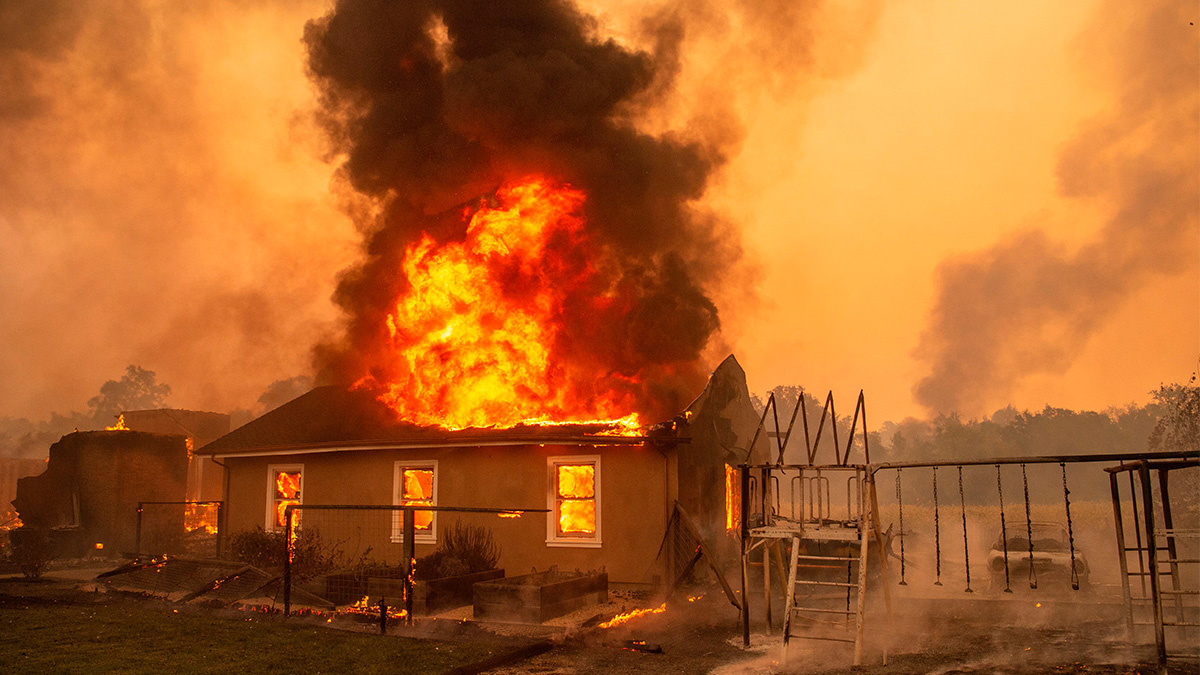

A home burns at a vineyard during the Kincade fire near Geyserville, California on Oct. 24. JOSH EDELSON / AFP via Getty Images
The Kincade Fire, which ignited Wednesday night in California‘s Sonoma County, has now spread to 16,000 acres and forced around 2,000 people to flee their homes, the San Francisco Chronicle reported Thursday.
Evacuees included the more than 900 residents of the town of Geyserville, BBC News reported. One of them was 68-year-old Dwight Monson, who told the Los Angeles Times he thought his home would be safe until he saw the hills behind his ranch on fire.
“We’ve never seen Black Mountain burn,” Monson told the Los Angeles Times. “We thought we were a couple of miles from the fire. But guess what — the winds.”
The fire was driven by gusts of up to 60 miles per hour, according to the San Francisco Chronicle. It has so far destroyed 49 homes and structures and is five percent contained. No one has been reported killed or missing.
Windy, dry weather in Northern California had already prompted utility company Pacific Gas and Electric (PG&E) to shut off power to around 27,830 customers in Sonoma County Wednesday and 178,000 statewide. The outages meant that many people had to evacuate their homes in darkness. Despite this, it is possible the utility could still have ignited the Kincade Fire.
That’s because equipment on a transmission tower broke near where the fire erupted, the San Francisco Chronicle reported. PG&E noticed an outage at the tower around the same time that the fire ignited at 9:25 p.m. Wednesday. The company said the transmission lines had remained live following the power shutoff, but it is not yet known if the incident actually caused the fire, according to the Los Angeles Times.
“They shut off the power and we still had a fire,” Geyserville resident Madonna Tavares, 70, told the Los Angeles Times. “I don’t understand it.”
The Kincade Fire isn’t the only blaze burning in California. In Los Angeles County, the fast-moving Tick Fire burned 5,000 acres and threatened homes, NPR reported.
Conditions could also get more difficult over the weekend, as PG&E is planning even more preventative power outages due to strong wind warnings, according to the San Francisco Chronicle.
Wired explained how the climate crisis is combining with seasonal weather patterns to fuel severe autumn wildfires in California, such as the Tubbs Fire that killed 22 in October of 2017 and the Camp Fire that destroyed the town of Paradise in November of 2018:
Every autumn, winds blow in from the northeast, heating up and picking up speed as they descend through mountain valleys. This sucks moisture out of vegetation, turning it into the perfect fuel for wildfires.
In the past, the state would have had at least some rain to hydrate vegetation after the summer. Thanks to climate change, that’s largely not the case anymore. All it takes is one spark to ignite ultra-dry brush, and high winds will carry that flame with incredible speed, overwhelming communities like Paradise, where many residents simply didn’t have time to escape.
Gov. Gavin Newsom criticized utility companies like PG&E for failing to adapt to this new normal.
“This is unacceptable,” he said in a press conference Thursday reported by the Los Angeles Times. “Issues of corporate greed meeting issues of climate change have created these conditions.”
- A Trailblazing Plan to Fight California Wildfires | The New Yorker
- California Fire Tracker: Wildfire map for Northern, Central and ...
- Climate change: Southern California's worst-case wildfire scenario ...
- Kincade Fire burns 16000 acres in Sonoma County, as PG&E ...
- Pacific Gas and Electric power line broke before Kincade Fire ...

 233k
233k  41k
41k  Subscribe
Subscribe 